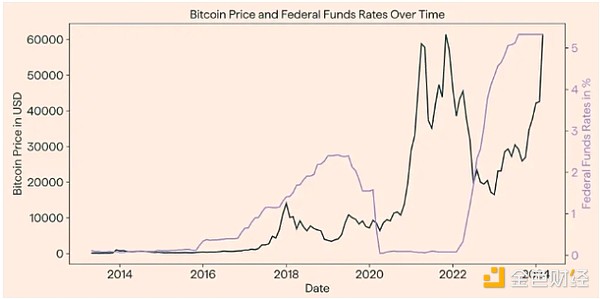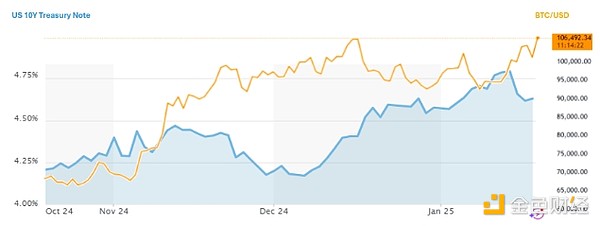Author: Marie Poteriaieva, CoinTelegraph; Translator: Tong Deng, Jinse Finance
When to buy and when to sell Bitcoin is a decision that still confuses investors. There are more and more factors affecting the price, and for this highly volatile asset, it is crucial to develop a method to consistently avoid losses and generate profits.
Recently, Bitcoin analyst and Cane Island Digital founder Timothy Peterson shared a cheat sheet containing 8 macroeconomic factors that affect Bitcoin's price. Let's take a look at the first 3 indicators, understand their relationship with Bitcoin's price, and dive deeper into the best buying and selling opportunities.
US Dollar Index (DXY)
DXY measures the value of the US dollar against a basket of major currencies. It is influenced by factors such as interest rates, geopolitics, domestic economic conditions, and foreign exchange reserves held in US dollars.
A strong DXY often has a negative impact on Bitcoin's price. Conversely, when confidence in this index weakens, investors turn to risk assets, stocks, and Bitcoin. As recent NYDIG research has shown, this inverse relationship has existed for years and will continue until 2024.

Correlation of Bitcoin with stocks, gold, and the US dollar. Source: NYDIG, Bloomberg
Since September 2024, the US Dollar Index has been on an upward trend, reaching 110, the highest level in over two years. Some analysts believe this portends a bearish outlook for Bitcoin. However, according to Michael Boutros, Senior Technical Strategist at Forex.com, this rebound is approaching long-term resistance. If this resistance holds, it could reverse the trend, creating a more favorable environment for Bitcoin.
Since reaching its peak on January 13, the US Dollar Index has fallen 1.27%, but the incoming Trump administration may reverse this trend, depending on its cabinet policies.
Federal Reserve Benchmark Interest Rate and Bitcoin
The Federal Reserve's interest rate affects borrowing costs across the United States. Lower interest rates make borrowing less expensive, stimulating demand for risk assets. Conversely, rising interest rates often cause investors to prefer yield-generating assets like bonds.
Bitcoin is also considered a risk asset. Researchers at Piguet Galland, a Swiss bank, have studied the long-term correlation between BTC and interest rates.

Changes in Bitcoin price and the federal funds rate over time. Source: Piguet Galland
The chart shows that in the post-pandemic era, after rate cuts, BTC soared to a cycle high near $69,000, exhibiting a negative correlation. Subsequently, in 2022, there was a significant rate hike, during which BTC fell to a cycle low of $16,000. This pattern suggests that Bitcoin is still viewed as a risk asset.
In addition to the Federal Open Market Committee (FOMC) meetings, which are typically held eight times a year, traders also use other economic indicators, such as the Consumer Price Index (CPI), as data points that negatively correlate with Bitcoin's price and market inflation expectations.
When monthly CPI data is released, market expectations are often more important than the original figures. For example, the December 2024 CPI showed an annual inflation rate of 2.9%, in line with market expectations. The core CPI, excluding food and energy, was 3.2%, better than the expected 3.3%. Although still above the Federal Reserve's 2% target, it provided some relief to the market. After the announcement, the S&P 500 index immediately rose 1.83%, the Nasdaq 100 index rose 2.3%, and Bitcoin rose 4.3%.
So far, as quantitative market analyst Benjamin Cowen has said, for Bitcoin, "in an inflationary environment, good news is good news." Declining inflation often drives BTC higher. However, Bitcoin also has another side - its role as digital gold, often touted as a hedge against inflation. In this paradigm, as more people turn to Bitcoin to defend against dollar devaluation, rising inflation should drive BTC higher. As Bitcoin becomes more widespread, this scenario may become a reality, reversing the current correlation.
The Impact of Bond Yields on Bitcoin
Bond yields are directly related to Federal Reserve interest rates and inflation, and are another important indicator for Bitcoin traders. High yields on low-risk government bonds may reduce the attractiveness of high-risk assets like Bitcoin that do not generate yield.

Comparison of US 10-year Treasury yields and BTC/USD. Source: MarketWatch, Coinbase
Since December 2024, US long-term bond yields have been rising, reaching 4.77%, the highest level since 2023. Although the Federal Reserve has been cautious in cutting rates, raising concerns about the potential for soaring inflation, this growth has still occurred. During this period, Bitcoin's price performance has been largely negatively correlated with bonds, confirming this theory.
Government bonds are also directly related to the concept of debt. When the government issues more debt (sells more bonds) to finance spending, the increased supply can lead to higher yields. If debt reaches unsustainable levels, there is a risk of dollar devaluation. The US has added $13 trillion in debt since 2020, which is concerning for the economy and Bitcoin. However, in the long run, this may increase interest in Bitcoin as an alternative currency.
Bridgewater Associates CEO Ray Dalio recognized this possibility. In a speech at the Abu Dhabi Finance Week, the billionaire said he prefers "hard currencies" over debt investments, "I want to be far away from bonds and debt assets, and hold some hard currencies like gold and Bitcoin."
Dalio pointed out that the rise in global debt may reduce the value of fiat currencies, and predicted that a debt crisis is inevitable. Therefore, high bond yields may indicate that the economy cannot sustain its own debt, which in turn could reverse the current correlation between Bitcoin and bonds.







